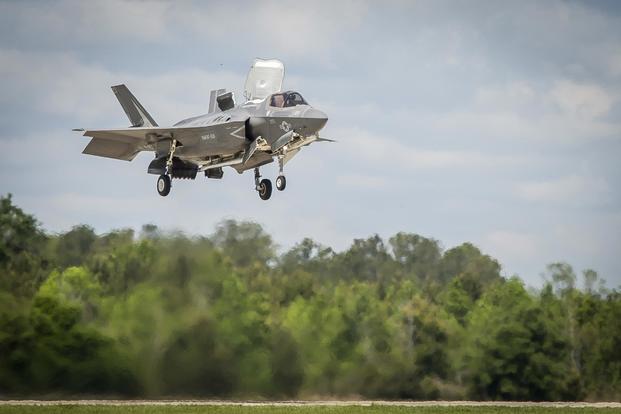It's official: top Pentagon officials will not clear the F-35 Joint Strike Fighter for full-rate production this year, after setbacks during a crucial testing phase.
Under Secretary of Defense for Acquisition and Sustainment Ellen Lord on Friday said officials may not sign off on the F-35 full-rate production milestone -- a sign of confidence in the program to produce more fighter jets -- until as far out as January 2021 because of the latest testing lapse.
"I'm going to make some decisions about when that full-rate production decision will be made shortly," Lord said at a briefing at the Pentagon Friday.
Last month, it was revealed that the Lockheed Martin-made F-35 would not complete its already-delayed formal operational test phase by the new fall deadline due to a setback in the testing process.
Related: F-35 Testing Delays Continue, Even as Aircraft Has Made Its Combat Debut
Military.com first reported that while F-35 Initial Operational Test and Evaluation (IOT&E) was supposed to be complete by late summer, the testing was incomplete due to an unfinished phase known as the Joint Simulation Environment. The F-35 Joint Program Office and Pentagon at the time confirmed the delay.
"We are not making as quick progress on the Joint Simulation Environment integrating the F-35 into it," Lord told reporters during the briefing. "It is a critical portion of IOT&E," she said, adding inspectors need to get JSE "absolutely correct" before further testing can be done.
The Office of the Secretary of Defense would be the authority to sign off on the decision, moving the program out of its low-rate initial production (LRIP) stage.
The JSE simulation projects characteristics such as weather, geography and range, allowing test pilots to prove the aircraft's "full capabilities against the full range of required threats and scenarios," according to a 2015 Director, Operational Test & Evaluation (DOT&E) report.
JPO spokeswoman Brandi Schiff in September said the JSE is in the process of integrating Lockheed's "'F-35 In-A-Box' (FIAB) model, which is the simulation of F-35 sensor systems and the overall aircraft integration." FIAB is the F-35 aircraft simulation that plugs into the JSE environment.
"This integration and the associated verification activities are lagging [behind] initial projections and delaying IOT&E entry into the JSE," Schiff said at the time.
Lockheed Martin originally proposed a Virtual Simulator program for this testing. But in 2015, the government instead opted to transition the work -- which would become the JSE -- to Naval Air Systems Command at Naval Air Station Patuxent River, Maryland.
In December, the JPO and Lockheed announced that all three F-35 variants belonging to the Air Force, Navy and Marine Corps would be field-tested "for the purposes of determining the weapons systems' operational effectiveness and operational suitability for combat."
The testing had originally been set to begin in September 2018.
IOT&E paves the way for full-rate production of the Lightning II. Three U.S. services and multiple partner nations already fly the aircraft.
Some versions of the F-35 have even made their combat debut.
-- Oriana Pawlyk can be reached at oriana.pawlyk@military.com. Follow her on Twitter at @oriana0214.
Read More: Air Force Denies Report More Security Forces Sent to Incirlik











